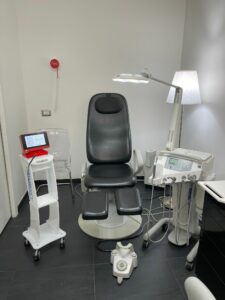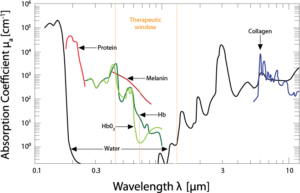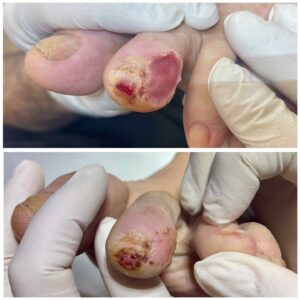In podiatry, lasers are used to assist several procedures, from tissue’s vaporization to nail fungus reduction as well as to accelerate healing. Although there are different type of lasers in the market, the Nd:YAG, the CO2 and the diode laser are the most common and used in Podiatry clinic.
 Concerning the diode laser devices, few essential points should be taken in consideration:
Concerning the diode laser devices, few essential points should be taken in consideration:
* Wavelength: it indicates the level of absorption and dispersion of a specific laser light with principles human body’s chromophores as water, hemoglobin, melanin, cytochrome C oxidase etc.. Choosing the right wavelength is, thus, fundamental to provide the desired effects and activate a specific laser-related process called photobiomodulation. The photobiomodulation is a natural thermal process activated by the application of laser therapy with wavelength from 400nm to 110nm. This process stimulates endogenous human body’s chromophores and produces photochemical and photophysical effects. This process results in pain & inflammation relief, immune system strengthen, bacteria/fungus reduction and a faster wound healing.
* Power output: Choosing the right amount of power to deliver to the tissue is important to avoid burning and tissue damages. There are some controversial aspects on the deep of penetration related to the use of high powers compared to low powers but some scientific articles shows that higher powers/average powers just allows to deliver higher amount of energy to the tissue saving time of operation. High power output is not related to the success of treatment.
* Spot diameter: The diameter of laser beam shows basically the area of treatment. Larger spot allows to cover more tissue’s area and thus deliver the right amount of energy in shorter time. It’s also important to evaluate the features of the beam emitted by the device, which are mostly related to the manufacturer and accessories provided:
Focalised laser beam 🡪 There’s no dispersion of laser energy in time and in space. The beam stays clearly visible as a circle which cover the tissue.
Defocalized laser beam 🡪 There’s laser energy dispersion related to the distance of application. If the handpiece is moved close and away to the tissue, a significant drop of the power can be detected.
Normally, to perform that test a calibrated power meter is required. The table below shows that not every laser wavelength is useful to activate the photobiomodulation.

Which foot conditions can be treated with the laser therapy? Diode lasers used in Podiatry are especially effective in reducing inflammation, swelling, and pain. As such, the foot conditions that respond best to laser therapy are:
- Neuroma – Thickening of the tissue surrounding nerves
- Plantar fasciitis – Inflammation of the plantar tissue extending from the heel to the base of the toes
- Diabetic ulcers – Ulcerations caused by changes in blood circulation in diabetic patients
- Arthritis – A condition associated with joint degeneration
- Tendonitis – Tendon-related pain caused by overuse, injury, or wear and tear
- Onychomycosis – Onychomycosis is an infection of the nail caused by fungi such as dermatophytes, non-dermatophyte moulds and yeasts (mainly Candida species)
- Warts / granuloma /laser-assisted onychocryptosis – painful tissue inflammation located in a point of the foot or close to the nail

What to expect during a laser therapy session?
Laser therapy is painless, has no side effects, and does not require any anesthesia or post-procedure care. Some patients report a slight warming sensation during the procedure but nothing more. In case of tissue vaporization as warts remotion, the use of neutral spray ice is suggested to cooling down the area. A typical laser therapy session lasts fifteen minutes and does not require any special preparation just follows standard methods and clinical approach.
How many sessions do you need?
For less severe painful conditions, you can get significant relief within one or two sessions. However, with an increase in severity, you might need more sessions. Typically, Podiatrist might recommend up to six sessions for acute pain, while chronic conditions and mycosis might require 8 or more sessions, spread out in one, two to three sessions per week.
Scientific articles
https://www.ncbi.nlm.nih.gov/pmc/articles/PMC6199788/
https://www.hmpgloballearningnetwork.com/site/podiatry/how-can-class-iv-lasers-fit-your-practice